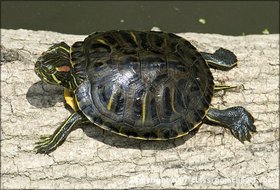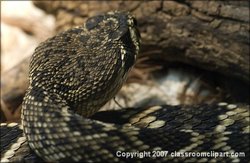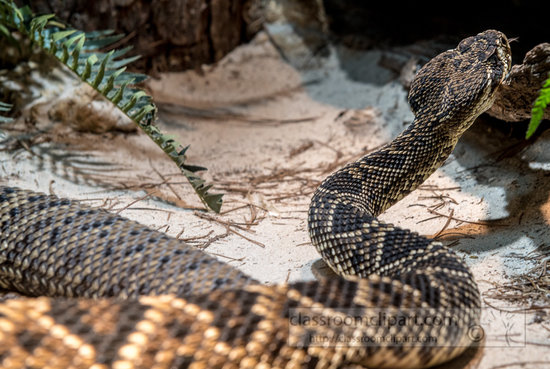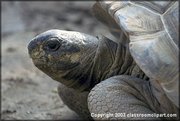Reptile
|
|
| Reptiles | ||||||
|---|---|---|---|---|---|---|
 Eastern Herman's Tortoise | ||||||
| Scientific classification | ||||||
| ||||||
| Orders | ||||||
|
Crocodylia - Crocodilians |
The reptiles are a group of vertebrate animals. Reptiles are tetrapods, and also are amniotes (animals whose embryos are surrounded by an amniotic membrane). Today they are represented by four orders:
- Order Crocodylia (crocodiles and alligators): 23 species
- Order Rhynchocephalia (tuataras from New Zealand): 2 species
- Order Squamata (lizards, snakes and amphisbaenians {"worm-lizards"}): approximately 7,600 species
- Order Testudines (turtles): approximately 300 species
Reptiles are found on all continents except for Antarctica, although their main distribution comprises the tropics and subtropics. Modern species of reptiles do not generate sufficient body heat to maintain a constant body temperature (see Leatherback Sea Turtle for an exception to this). Instead they rely on gathering and losing heat from the environment to regulate their internal temperature, such as by moving between sun and shade, or by preferential blood circulation (moving warmed blood into the body core, while pushing cool blood to the periphery). In their natural habitats, most species are adept at this, and can maintain mammalian, and even avian equivalent core body temperatures within a fairly narrow range. While this lack of internal heat imposes costs, in terms of requiring behavioral regulation. It also provides a large benefit by allowing for more efficient use of food. A reptile can survive on much less food than comparably sized mammals and birds, who burn most of their food for warmth. Most reptile species are oviparous (egg-laying). Many species of squamates, though, are capable of giving live birth. This is achieved, either through ovoviviparity (egg retention), or viviparity (babies born through no use of calcified eggs). Many of the viviparous species feed their young through various forms of placenta, just like mammals (Pianka & Vitt, 2003 pgs: 116-118).
However, note the taxonomy issues described below; mammals and birds can also be viewed as descendants of reptiles.
| Contents |
Classification of reptiles
Reptiles classically included all the amniotes except birds and mammals. Thus reptiles were defined as the set of animals that includes crocodiles, alligators, tuataras, lizards, snakes, amphisbaenians and turtles, grouped together as the class Reptilia (Latin repere, "to creep"). This is still the usual definition of the term.
However, in recent years many taxonomists have begun to insist that taxa should be monophyletic, that is, groups should include all descendants of a particular form. The reptiles as defined above would be paraphyletic, since they exclude both birds and mammals, although these also developed from the original reptile. Colin Tudge writes:
- Mammals are a clade, and therefore the cladists are happy to acknowledge the traditional taxon Mammalia; and birds, too, are a clade, universally ascribed to the formal taxon Aves. Mammalia and Aves are, in fact, subclades within the grand clade of the Amniota. But the traditional class reptilia is not a clade. It is just a section of the clade Amniota: the section that is left after the Mammalia and Aves have been hived off. It cannot be defined by synamorphies, as is the proper way. It is instead defined by a combination of the features it has and the features it lacks: reptiles are the amniotes that lack fur or feathers. At best, the cladists suggest, we could say that the traditional Reptila are 'non-avian, non-mammalian amniotes'. (Tudge, p.85)
Some cladists thus redefine Reptilia as a monophyletic group, including both the classic reptiles as well as the birds and perhaps the mammals (depending on ideas about their relationships). Others abandon it as a formal taxon altogether, dividing it into several different classes. However, other biologists believe that the common characters of the standard four orders are more important than the exact relationships, or feel that redefining the Reptilia to include birds and mammals would be a confusing break with tradition. A number of biologists have adopted a compromise system, marking paraphyletic groups with an asterisk, e.g. class Reptilia*. Colin Tudge notes other uses of this compromise system:
- By the same token, the traditional class Amphibia becomes Amphibia*, because some ancient amphibian or other gave rise to all the amniotes; and the phylum Crustacea becomes Crustacea*, because it may have given rise to the insects and myriapods (centipedes and millipedes). If we believe, as some (but not all) zoologists do, that myriapods gave rise to insects, then they should be called Myriapoda*....by this convention Reptilia without an asterisk is synonymous with Amniota, and includes birds and mammals, whereas Reptilia* means non-avian, non-mammalian amniotes. (Tudge, p.85)
Evolution of the reptiles
Several thousand fossil species showing a clear smooth transition from the ancestors of reptiles to present-day reptiles exist.
The first true "reptile" or Amniotes are categorized as Anapsids, having a solid skull with holes only for nose, eyes, spinal cord, etc. Turtles are believed by some to be surviving Anapsids, as they also share this skull structure, but this point has become contentious lately, with some arguing that turtles reverted to this primitive state in order to improve their armor. Both sides have strong evidence, and the conflict has yet to be resolved.
Shortly after the first reptiles, two branches split off, either from the Anapsids or simply from each other, leaving no proper Anapsids. One group, the Synapsida, had a pair of holes in their skulls behind the eyes, which were used to both lighten the skull and to increase the space for jaw muscles. The other group, Diapsid, possessed the same holes, along with a second pair located higher on the skull. The Synapsida eventually evolved into mammals, while Diapsida split yet again into two lineages, the lepidosaurs (which contain modern snakes, lizards, and tuataras, as well as (debatably) the extinct sea reptiles of the Mesozoic) and the archosaurs (modernly represented by only crocodiles and birds, but containing pterosaurs and dinosaurs).
Systems
Circulatory
Most reptiles have closed circulation via a three-chambered heart consisting of two atria and one, variably partitioned ventricle. There is usually one pair of aortic arches. In spite of this, due to the fluid dynamics of blood flow through the heart, there is little mixing of oxygenated and deoxygenated blood in the three-chambered heart. Furthermore, the blood flow can be altered to either shunt deoxygenated blood to the body, or oxygenated blood to the lungs, which gives the animal greater control over its blood flow, allowing more effective thermoregulation and longer diving times for aquatic species. There are some interesting exceptions among reptiles. For instance Crocodylians have an incredibly complicated four-chambered heart that is capable of becoming a functionally three-chambered heart during dives (Mazzotti, 1989 pg 47). Also, it has been discovered that some snake and lizard species (e.g. monitor lizards and pythons) have three-chambered hearts that become functional four-chambered hearts during contraction. This is made possible by a muscular ridge that subdivides the ventricle during ventricular diastole and completely divides it during ventricular systole. Because of this ridge, some of these squamates are capable of producing ventricular pressure differentials that are equivalent to those seen in mammalian and avian hearts (Wang et al, 2003).
Respiratory
All reptiles breathe using lungs. Reptiles don't normally breathe through their skin. The only exceptions to this are in aquatic turtles. These animals have developed more permeable skin, and even gills in their anal region, for some species (Orenstein, 2001). Even with these adaptations, breathing is never fully accomplished without lungs. Lung ventilation is accomplished differently in each main reptile group. In squamates the lungs are ventilated almost exclusively by the axial musculature. This is also the same musculature that is used during locomotion. Because of this constraint, most squamates are forced to hold their breath during intense runs. Some, though, have found a way around it. Varanids, and a few other lizard species, employ buccal pumping as a complement to their normal "axial breathing." This allows the animals to completely fill their lungs during intense locomotion, and thus remain aerobically active for a long time. Tegu lizards are known to possess a proto-diaphragm, which separates the pulmonary cavity from the visceral cavity. While not actually capable of movement, it does allow for greater lung inflation, by taking the weight of the viscera off the lungs (Klein et al, 2003). Crocodylians actually have a muscular diaphragm that is analogous to the mammalian diaphragm. The difference here, is that the muscles for this diaphragm pull the pubis (part of the pelvis, which is movable in crocodylians) back, which brings the liver down, thus freeing space for the lungs to expand. This type of diaphragmatic setup has been referred to as the "hepatic piston." Finally, there are the Turtles & Tortoises. How these animals breathe, has been the subject of much study. To date, only a few species have been studied thoroughly enough to get an idea of how turtles do it. The results indicate that turtles & tortoises have found a variety of solutions to this problem. Some turtles such as the Indian flapshell (Lissemys punctata) have a sheet of muscle that envelopes the lungs. When it contracts, the turtle can exhale. Many turtles & tortoises use special muscles, mixed with the use of their forelimbs, to accomplish breathing. Turtle lungs are attached to the inside of the top of the shell (carapace), with the bottom of the lungs attached (via connective tissue) to the rest of the viscera. By using a series of special muscles (roughly equivalent to a diaphragm), turtles are capable of pushing their viscera up and down; resulting in effective respiration. Since many of these muscles have attachment points in conjunction with their forelimbs (indeed, many of the muscles expand into the limb pockets during contraction), Turtles are actually capable of forcing air in and out, just by walking. Though turtles & tortoises have acquired a variety of different ways to achieve their breathing, one thing remains the same. They all must hold their breath when they withdraw into their shell (Orenstein, 2001).
Most reptiles lack a secondary palate. This means they must hold their breath while swallowing. Crocodylians have evolved a bony secondary palate that allows them to continue breathing while remaining submerged (and protect their brains from getting kicked in by struggling prey). Skinks (family Scincidae) also have evolved a bony secondary palate, to varying degrees. Snakes took a different approach and extended their trachea instead. Their tracheal extension sticks out like a fleshy straw, and allows these animals to swallow large prey without suffering from asphyxiation.
Excretion
Excretion is performed mainly by two small kidneys. In diapsids, uric acid is the main nitrogenous waste product; turtles, like mammals, excrete mainly urea. Unlike the kidneys of mammals and birds, reptile kidneys are unable to produce liquid urine more concentrated than their body fluid. This is because they lack a specialized structure called a loop of Henle, which is present in the nephrons of birds and mammals. Because of this, many reptiles use the colon to aid in the reabsorption of water. Some are also able to take up water stored in the bladder. Excess salts are also excreted by nasal and lingual salt glands in some reptiles.
Nervous
The reptilian nervous system contains the same basic part of the amphibian brain, but the reptile cerebrum and cerebellum are slightly larger. Most typical sense organs are well developed with certain exceptions, most notably the snake's lack of external ears (middle and inner ears are present). There are twelve pairs of cranial nerves. Due to their short cochlea, reptiles use electrical tuning to expand their range of audible frequencies.
Reproduction
Reptiles generally reproduce sexually, though some are capable of asexual reproduction. Most reptiles lay amniotic eggs covered with leathery or calcareous shells. An amnion, chorion, and allantois are present during embryonic life. The eggshell protects the crocodile embryo and keeps it from drying out, but it is flexible to allow gas exchange. The chorion aids in gas exchange between the inside and outside of the egg. It allows carbon dioxide to exit the egg and oxygen gas to enter the egg.
Asexual reproduction has been identified in squamates in six families of lizards and one snake. In some species of squamates, a population of females is able to produce a unisexual diploid clone of the mother.




